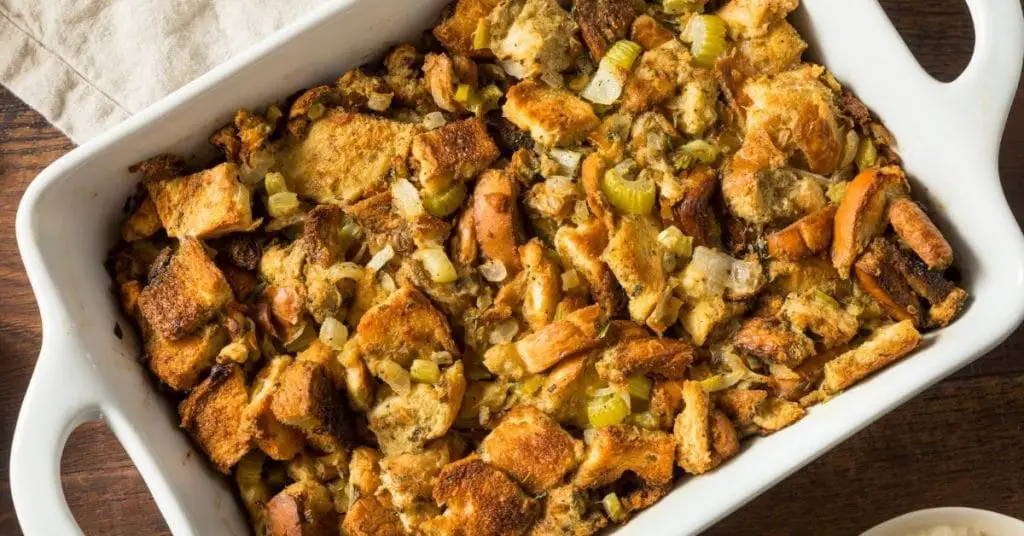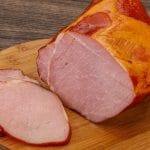In a nutshell: Yes, you can freeze cooked or uncooked stuffing. Properly cool and store it in an airtight container to maintain its texture and flavor. Avoid freezer burn by keeping it away from air and moisture.
Also known as filling or dressing, stuffing is a popular addition to festive holiday season meals such as Thanksgiving and Christmas. To some, a holiday meal just wouldn’t be complete without a side of stuffing.
Whether you want to make the stuffing ahead of time or have a heap of Thanksgiving leftovers after the festivities, the good news is that you can freeze stuffing to prevent any of it from going to waste. Here is everything you need to know about freezing and reheating stuffing.
Can Stuffing Be Frozen?
Yes, you can freeze cooked leftover stuffing or uncooked stuffing. When preparing to freeze stuffing cooked, it should always be cooled to room temperature before packing for freezing.
Freezing warm stuffing will result in the formation of large ice crystals causing freezer burn and faster deterioration of the texture and flavor.
If you are planning to freeze stuffing that is cooked , it is best to remove it from the oven 10 minutes before it should be done and cool it down quickly. This will allow the stuffing to complete the cooking process when reheated after being frozen without becoming excessively dry or soggy.
The most important thing when freezing stuffing is to keep it free from contact with air and moisture by keeping it in an airtight container. This will help prevent freezer burn. Also, ensure that the stuffing is kept at a consistent temperature in the freezer.
How To Freeze Cooked Stuffing
Step 1: Cool
Freshly cooked stuffing needs to be completely cooled before packing. You can keep it in the fridge overnight before freezing, but freezing it as fresh as possible is best.
Step 2: Portion and Pack
Portion the cooled stuffing into the desired quantities and pack each portion into a resealable freezer bag. Lie the bag flat and press out any air before sealing tightly.
Step 3: Label and Freeze
Label the freezer bags with the date to keep track of how long it has been stored and place it in the freezer.
How To Freeze Uncooked Stuffing
Step 1: Prepare the Components
Uncooked stuffing can either be mixed and frozen ready to bake or you can freeze the different components separately. Prepare your stuffing as desired.
Step 2: Pack
Place the stuffing into the tray you are going to use to cook it in (this would need to be both a freezer and oven safe dish). This allows you to pull it straight from the freezer into the oven for baking without the hassle of thawing or needing extra dishes.
Alternatively, you can scoop the mixture or various separate components into resealable freezer bags. Make sure to press out any excess air from the bag before sealing it.
Step 3: Wrap
Wrap the baking sheet or dish containing the stuffing in a layer of plastic wrap or cling film. Then, wrap it again in a layer of aluminum foil. Ensure that all the corners are sufficiently sealed with no gaps left open where air can enter.
Step 4: Label and Freeze
Label the wrapped tray or freezer bags with the date to keep track of how long it has been stored and place it in the freezer.
How To Thaw and Reheat Frozen Stuffing
Since you can reheat stuffing or cook it straight from frozen it does not require thawing. If you defrost stuffing first, it can completely change the texture. It is, therefore, best taken straight from the freezer to reheat. No one wants soggy stuffing.
Preheat your oven to 325 °F and place the frozen stuffing in an ovenproof baking dish. Cover the dish with aluminum foil. After baking for 15 minutes, remove the foil and bake for another 5 minutes until fully warmed. You can drizzle some chicken broth over the stuffing if you are concerned that it is too dry.
The cooking time will vary depending on the quantity and doneness of the stuffing when placing it into the oven. Frozen uncooked stuffing will need a much longer cook time.
Types of Stuffing
Stuffing is a mixture of dried breadcrumbs, onion, celery, spices, and dried or fresh herbs such as sage. The tasty mixture is served as a side dish or used as a filling to stuff a whole chicken, turkey, or even vegetables, eggs, and seafood.
Not only does stuffing bring a hearty flavor to a dish but it can also prevent the meat from drying out.
Other popular homemade stuffing varieties include the use of rice, cornbread, sweet potato, or quinoa instead of traditional breadcrumbs. Sausage, cranberries or cranberry sauce, chestnuts, dried fruits, nuts, and even oysters can be incorporated into various stuffing recipes to accompany the appropriate main dish.
FAQs
Conclusion
Whether you are making stuffing ahead of time to avoid last-minute Thanksgiving dinner chaos or have a stash of leftovers, freezing it is a great way to save time, money, and food going to waste.
Cooked or uncooked, stuffing is easy to freeze as long as it is kept free from contact with moisture and air. It is best to portion the stuffing into smaller quantities so you can just remove what you need from the freezer without having to thaw and use an entire batch at once.
Stuffing is not only great to fill meat and veggies, but is versatile and can be used as a delicious component in many dishes from breakfast all the way through to dinner.
Up next: How to freeze cornbread
*image by Stuffing/depositphotos









